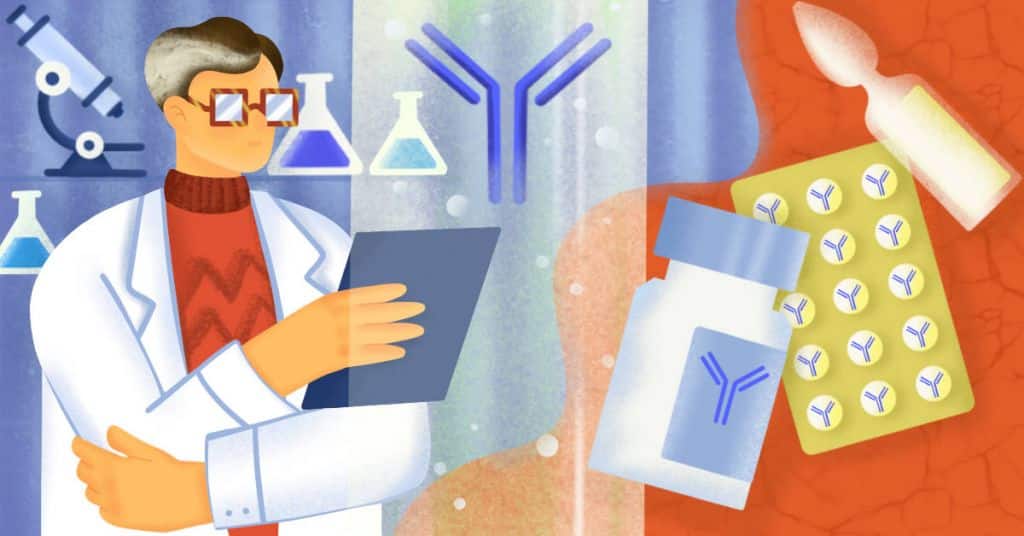Newsletter Signup - Under Article / In Page
"*" indicates required fields
The California startup IgGenix is aiming to re-engineer antibodies that mediate allergic responses into antibodies that can block this response. We spoke with IgGenix’s CEO Jessica Grossman and CTO Derek Croote to understand the potential of such a therapy.
Allergies are overreactions of the immune system to foreign substances that are normally harmless. Worldwide, and especially in industrialized countries, the prevalence of allergic diseases is on the rise, with food allergies in the population increasing from around 3 percent in 1960 to around 7 percent in 2018. At the same time, the range of food allergens — proteins that elicit an allergic cascade — has expanded beyond the eight major ones: milk, egg, peanut, tree nut, wheat, soy, fish and shellfish.
Allergic reactions can range from coughing, sneezing and rashes to more severe symptoms like difficulty breathing, low blood pressure and even death if not immediately treated. There is no cure, and allergies can only be managed through strict allergen avoidance or treatment, such as antihistamines that dampen the allergic immune response or desensitization therapy that trains the body out of overreacting. However, this is not entirely sufficient as accidental exposure can send some individuals into anaphylaxis (severe allergic reaction), which can be fatal.
New forms of treatment are thus needed, and this is where the California-based startup IgGenix comes in. A spinout of Stanford University, IgGenix was founded based on research by Stephen Quake, Kari Nadeau and Derek Croote who developed a novel discovery platform for isolating rare allergen-specific antibodies called IgE. By reengineering these key antibodies, IgGenix aims to develop first-in-class therapies to provide a better quality of life for the millions of people suffering from food and other severe allergies.
We talked to Jessica Grossman, CEO of IgGenix, and Derek Croote, CTO of IgGenix, to learn more about IgGenix’s technology and their SeqSifter single-cell RNA-sequencing discovery platform.

To start with, can you describe IgGenix’s approach to alleviating allergic reactions?
Derek Croote (DC): IgGenix takes a novel approach by re-engineering IgE monoclonal antibodies (mAbs) to block and even prevent allergic reactions. These IgE antibodies cause allergic reactions when they recognize an allergen after someone’s been exposed. So our single-cell RNA sequencing platform is based on the idea that we can discover the extremely rare single cells that produce IgE antibodies, allowing us to identify the sequences of individual IgE antibodies. Once we have those sequences, we can start the re-engineering process.
We retain the portion of the IgE antibody that binds to the allergen, and we swap out what’s known as the constant region — which binds to cells that cause reactivity — for the IgG’s constant region. In doing so we’ve retained the ability to bind the allergen, but have abrogated the antibody’s ability to bind cells involved in reactivity. And so that’s the IgE to IgG re-engineering process, and when these re-engineered antibodies are delivered, they can act as blockers.
What makes IgE antibodies a suitable resource as an antibody-based therapeutic for allergies?
Jessica Grossman (JG): IgE antibodies are extremely rare, they’re the rarest class of antibodies. But they’re also extremely high affinity. They’re extremely tight binders and they become in fact tighter and tighter over time in the body. What makes our platform special is we’re taking those exquisitely, tight binding regions off of the IgE and putting them on the IgG. The real breakthrough moment on our discovery platform was isolating out individual IgE antibodies. People have been able to isolate IgE antibodies before, but not individually, obtaining instead a mishmash, if you will, of IgE antibodies.
DC: IgEs are kind of like a vaccine booster working in the wrong direction. You know, when you receive a booster for a vaccine, you’re trying to improve the potency of your response against a foreign virus. In the case of allergy, accidental exposure to the allergen repeatedly improves the potency of your IgE response against it. And so what we’ve done is we’ve recruited allergy clinics across the United States as part of an Institutional Review Board-approved observational study that allows us to identify individuals with the most severe allergies and the most potent IgE antibodies. We then get blood samples from those individuals so that we can create the best possible therapeutic for the allergic population broadly.
JG: Starting with whole blood from allergic donors, we already have that affinity and maturation of the antibodies. So before we even get the blood, the IgE antibodies have already become better and tighter binders in the individual.
Beyond isolating single IgE antibodies for developing therapies, can IgGenix’s discovery platform also be used to provide insights into the IgE class?
JG: Absolutely. And we’re certainly looking for collaborations with others who are interested in doing that because we do have a very rich data set. We have the largest library of IgE sequences in the world by 10 fold, currently in excess of 7,000 IgE sequences. No one has had these before. And since we’re a very small startup team in California, we’re looking for outside collaboration. Big pharma interest would be great. We think that there’s potentially a whole host of other disease and therapeutic applications.
What will treatments with IgGenix’s re-engineered antibodies look like?
JG: Our goal is to have a broadly applicable therapeutic for a specific allergy. So let’s say for peanut allergies, we now have samples across different individuals who are allergic to peanuts. When we looked at their antibodies, we found that the IgEs are binding to the same proteins and the same spots, or epitopes, on those proteins. So we can make a widely applicable blocker that will block those spots on multiple individuals.
The way that we’re envisioning it is a protective therapeutic that an individual would take and would need to take over time again, but do we know exactly how long do we know will it last or will it end up causing any other disease modification? That’s something we won’t know until we actually get into human trials and go through the U.S. Food and Drug Administration process, and see how the antibody interacts with people long term. Our goal is to really protect people from accidental exposures that really impact their daily lives: they can’t eat out, they can’t travel. And so we want to enable people to live a normal life and not live with this constant fear of eating something that has been accidentally exposed to peanuts and ending up in the emergency room.
How does your approach differ from desensitization therapy, which similarly blocks allergic reactions by increasing allergen-specific IgGs?
DC: People have been working on desensitization for a long time and there’s been progress. It can work for some people. The challenge is that it’s a very long process that often lasts anywhere from weeks to months to, in some cases, years. And it’s not guaranteed that it will work in the end; people have gone through years of therapy without any kind of lasting benefit. How we differ is that we’re providing a subcutaneous injection just under the skin, which should be kind of nearly immediately protective on the order of days. And so we’d be able to accelerate that process of being protected from accidental exposure.
JG: Yeah. In many ways, this is a passive desensitization therapy, meaning you don’t have to go through weeks or months of either allergy shots or oral allergy treatment to get an effect. Instead, we passively give you those IgG antibodies that are protective on day one.
There are already mAbs on the market for treating allergies, such as Genentech’s omalizumab and Regeneron’s dupilumab for severe asthma and eczema, respectively. Is there a difference between them and IgGenix’s re-engineered mAbs?
JG: Omalizumab is an anti IgE that binds the free IgE in the blood. So it takes a long time to work: It takes about 12 weeks to become effective. And then as soon as you stop taking it, your IgE rebounds. So one aspect is the length of time, where we think ours will be effective in a couple days. The other thing is that because omalizumab acts directly on IgE, if patients have very high IgE levels, it doesn’t work that well; it works better on patients with lower IgE levels.
DC: Dupilumab acts upstream of the IgE interaction with an allergen. And so it attempts to effectively downregulate the overall allergic response. And it works, but there are all of these steps that then have to happen subsequent to the intended effect in order to achieve something like desensitization. That’s why we really feel that our approach, which is directly addressing the allergen, is one in which we can achieve a fast response and address some of the individuals who are excluded from some of these products for various reasons.
Now that IgGenix has demonstrated isolation and re-engineering of IgE antibodies to IgG antibodies with high affinity to multiple tree nut allergens, when do you hope to begin phase 1 clinical trial testing for tree nut co-allergies?
JG: We closed a Series A financing a year ago, and we’re actually accelerating right now because we have identified a lead candidate that we want to get into the clinic as soon as possible. We are looking for investors for an upcoming Series B round. We hope to be in the clinic in about a year and a half.
Besides tree nut allergies, which other allergies is IgGenix hoping to target?
JG: We’re currently doing research on tree nuts, so walnut, pecan, pistachio and hazelnut allergies. Cat allergy is another area that we’ve done extensive research on as well as shellfish, and we have early research programs on milk, sesame and also alpha-gal syndrome, which is a red meat allergy. So we’re working on a very wide range of different outreaches.
With the advances we are seeing in immunotherapies ushering in a new era of mobilizing immune cells to fight off diseases, such as cancers and autoimmune diseases, do you think it will be possible to also achieve a cure for allergies?
DC: It’s very challenging to turn off the immune system once it decides that it doesn’t like something. First, we need to fully understand the complexity of the problem, and you can only do that by understanding the molecules that are driving reactivity. And that’s exactly what we’re doing with our SeqSifter platform, we’re discovering all of the IgE antibodies across all these different allergic diseases that are causative of disease. And so what we’re doing is trying to understand the underlying mechanisms involved. And hopefully we can build from there.
Artificial intelligence and the future of antibody discovery






